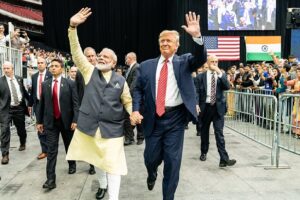Diplomacy is often a high-stakes balancing act, and the relationship between India and the United States has evolved significantly over the years. When Prime Minister Narendra Modi and President Donald Trump were in office, their meetings weren’t just routine diplomatic engagements—they were headline events that shaped global politics. With two strong-willed leaders at the helm, the real challenge wasn’t just about handshakes and photo ops. It was about how effectively India could align its priorities with America’s shifting strategies.

The Modi-Trump Dynamic: Different Styles, Common Interests
Both Modi and Trump had distinct leadership styles. Modi, a reformist with a vision for making India a global economic and strategic powerhouse, sought deeper ties with the U.S. Trump, on the other hand, championed an “America First” policy, prioritizing deals that favoured the U.S. economy. Despite their differences, the two leaders managed to build a rapport that helped push key discussions forward.
However, the real test was whether India could shape U.S. policies in ways that benefited its own long-term goals. Let’s take a look at the key areas where they worked together—and the challenges that came with it.
1. Trade and Economic Relations: Finding Middle Ground
Trade was a thorny issue in U.S.-India relations under Trump. While both countries saw enormous trade potential, friction points emerged. Trump’s administration pushed for more favorable terms for American companies, while India aimed for greater market access and fairer trade policies. The revocation of India’s Generalized System of Preferences (GSP) status in 2019 was a significant blow, removing duty-free access for many Indian exports.
Despite these setbacks, Modi and Trump worked to keep trade ties intact. India positioned itself as a lucrative market for American goods, including energy, defence equipment, and technology. By highlighting India’s massive consumer base and growing economy, Modi made a case for stronger economic cooperation that could be beneficial for both sides.
2. Strengthening Defence and Strategic Ties
One of the biggest successes of the Modi-Trump era was in defence cooperation. The U.S. officially recognized India as a “Major Defence Partner,” leading to billions of dollars in defence deals. India acquired advanced military equipment, including Apache and Chinook helicopters, to bolster its defence capabilities.
More importantly, both nations had a shared interest in countering China’s growing military presence in the Indo-Pacific. The U.S. saw India as a key player in its Indo-Pacific strategy, while India needed strong allies to balance China’s influence in the region. This strategic alignment helped India secure crucial defence collaborations while staying true to its independent foreign policy.
3. Counterterrorism: A Shared Priority
Terrorism has been a major concern for India, especially regarding cross-border attacks from Pakistan-based groups. Under Trump, the U.S. took a firmer stance on Pakistan, echoing India’s demand for stronger action against terrorism.
One of the biggest diplomatic wins for India came when the U.S. backed its push to blacklist Pakistani terrorist leaders in international forums. Intelligence sharing between the two nations also improved, strengthening security cooperation. By aligning its counterterrorism agenda with Washington’s broader security interests, India reinforced its position as a key partner in global counterterrorism efforts.
4. The Indo-Pacific Strategy and Managing China’s Rise
If there was one area where India and the U.S. found common ground quickly, it was in the Indo-Pacific. With China expanding its influence aggressively—whether through territorial claims in the South China Sea or economic expansion via the Belt and Road Initiative—both countries saw the need to counterbalance Beijing’s rise.
The U.S. pushed for stronger Indo-Pacific alliances, including revitalizing the Quad—a strategic grouping of India, the U.S., Japan, and Australia. India, while cautious about being seen as part of an anti-China coalition, worked to ensure its regional security interests were well-integrated into U.S. policies. By doing so, Modi secured India’s place as a central player in shaping the region’s future.
5. Expanding Energy and Technology Partnerships
Energy security was another key area of cooperation. Under Trump, the U.S. ramped up energy exports, giving India an opportunity to diversify its oil and gas imports. This reduced India’s reliance on Middle Eastern suppliers and strengthened its energy security.
In technology, the partnership expanded into fields like artificial intelligence, space exploration, and cybersecurity. As a growing tech hub, India positioned itself as a strategic partner for American companies looking to invest in cutting-edge innovation. The challenge was ensuring that technology transfer agreements and regulatory policies remained fair to Indian interests.
Challenges in Aligning Interests
Despite these successes, there were several friction points:
- Trade Tensions: The U.S. imposed tariffs on Indian products, and negotiations over a trade deal remained difficult.
- Immigration Policies: Trump’s restrictions on H-1B visas hurt Indian professionals and IT companies, creating diplomatic hurdles.
- Geopolitical Uncertainties: While India and the U.S. shared concerns about China, India had to carefully balance its relationships with Russia, Iran, and other key partners.
The Road Ahead: Lessons from the Modi-Trump Era
The Modi-Trump years set the foundation for a stronger Indo-U.S. relationship, but the real test lay in how these ties evolved beyond individual leaders. With changes in leadership, policies might shift, but the core strategic interests remain the same.
India’s approach of aligning its priorities with U.S. interests while maintaining its strategic autonomy was a lesson in smart diplomacy. Whether in trade, defence, security, or technology, India successfully embedded its preferences into broader U.S. policy frameworks, ensuring long-term gains.
As global geopolitics continue to shift, the lessons from this era will remain valuable in shaping future Indo-U.S. engagements. The key, as always, will lie in striking the right balance—aligning interests without compromising national priorities.
